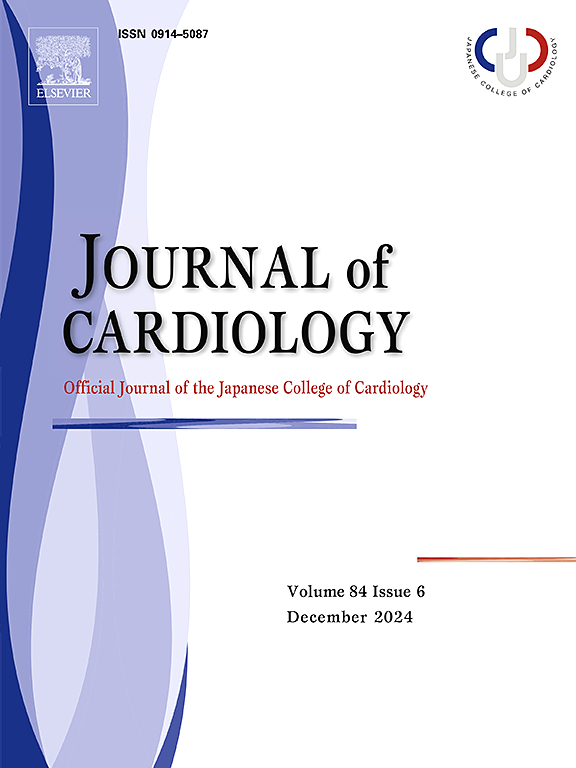膜联蛋白A1和膜联蛋白A2对缺血性卒中及其亚型的因果影响:一项双样本孟德尔随机研究。
IF 2.6
3区 医学
Q2 CARDIAC & CARDIOVASCULAR SYSTEMS
引用次数: 0
摘要
背景:临床前研究表明,膜联蛋白A1和膜联蛋白A2具有抗炎作用,可减缓动脉粥样硬化的进展,并进一步降低缺血性卒中的风险。由于膜联蛋白与缺血性脑卒中的因果关系尚不确定,本研究旨在采用双样本孟德尔随机化(MR)方法研究两者的因果关系。方法:与膜联蛋白A1和膜联蛋白A2相关的遗传工具来自一项来自INTERVAL研究的50,000名参与者的欧洲血统全基因组关联研究(GWAS)。缺血性卒中和缺血性卒中亚型的汇总统计数据来自MEGASTROKE联盟的GWAS数据集,涉及40,585例病例和406,111例欧洲血统的对照。采用反方差加权法进行主分析,然后进行一系列敏感性分析进行稳健性验证。结果:在初步分析中,基因预测的高膜联蛋白A1水平与缺血性卒中风险降低相关(OR = 0.96;95 % CI = 0.93 - -0.99;p = 0.023)和大动脉卒中(OR = 0.88;95 % CI = 0.81 - -0.96; = 0.004页)。同样,基因预测的高膜联蛋白A2水平也与缺血性卒中风险降低有显著关联(OR = 0.97;95 % CI = 0.95 - -1.00;p = 0.019)和大动脉卒中(OR = 0.90;95 % CI = 0.85 - -0.96; = 0.001页)。结论:在这项双样本MR研究中,我们发现膜联蛋白对缺血性卒中,特别是大动脉卒中具有因果保护作用。这些基因的生物学作用有待进一步的基础机制研究。本文章由计算机程序翻译,如有差异,请以英文原文为准。

Causal effects of Annexin A1 and Annexin A2 on ischemic stroke and its subtypes: A two-sample Mendelian randomization study
Background
Preclinical studies have suggested that Annexin A1 and Annexin A2 act as anti-inflammatory agents, slowing the progression of atherosclerosis and further potentially reducing the risk of ischemic stroke. Since the causality of Annexins and ischemic stroke remains uncertain, this study aimed to investigate the causal effects of both using a two-sample Mendelian randomization (MR) method.
Methods
The genetic instruments associated with Annexin A1 and Annexin A2 originated from a European-descent genome-wide association study (GWAS) of 50,000 participants from the INTERVAL study. Summary statistics for ischemic stroke and ischemic stroke subtypes were derived from the MEGASTROKE consortium's GWAS dataset, involving 40,585 cases and 406,111 controls of European ancestry. The inverse-variance weighted method was utilized in the main analysis, followed by a series of sensitivity analyses for robustness validation.
Results
In the primary analysis, genetically predicted high Annexin A1 levels were associated with decreased risks of ischemic stroke (OR = 0.96; 95 % CI = 0.93–0.99; p = 0.023) and large artery stroke (OR = 0.88; 95 % CI = 0.81–0.96; p = 0.004). Similarly, genetically predicted high Annexin A2 levels also had significant associations with decreased risks of ischemic stroke (OR = 0.97; 95 % CI = 0.95–1.00; p = 0.019) and large artery stroke (OR = 0.90; 95 % CI = 0.85–0.96; p = 0.001).
Conclusion
In this two-sample MR study, we found that Annexins had causal protective effects against ischemic stroke, especially large artery stroke. Further basic mechanistic studies should be conducted to investigate the biological roles of these genes.
求助全文
通过发布文献求助,成功后即可免费获取论文全文。
去求助
来源期刊

Journal of cardiology
CARDIAC & CARDIOVASCULAR SYSTEMS-
CiteScore
4.90
自引率
8.00%
发文量
202
审稿时长
29 days
期刊介绍:
The official journal of the Japanese College of Cardiology is an international, English language, peer-reviewed journal publishing the latest findings in cardiovascular medicine. Journal of Cardiology (JC) aims to publish the highest-quality material covering original basic and clinical research on all aspects of cardiovascular disease. Topics covered include ischemic heart disease, cardiomyopathy, valvular heart disease, vascular disease, hypertension, arrhythmia, congenital heart disease, pharmacological and non-pharmacological treatment, new diagnostic techniques, and cardiovascular imaging. JC also publishes a selection of review articles, clinical trials, short communications, and important messages and letters to the editor.
 求助内容:
求助内容: 应助结果提醒方式:
应助结果提醒方式:


